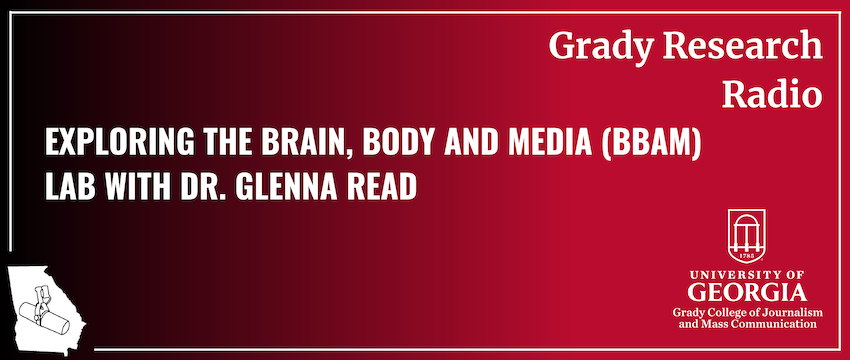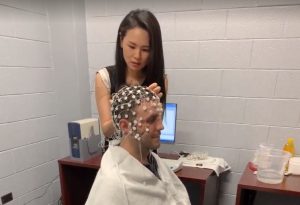Podcast: Exploring Grady College’s Brain, Body and Media (BBAM) Lab

Podcast: Exploring Grady College’s Brain, Body and Media (BBAM) Lab
Listen to Grady Research Radio
Apple Podcasts/Spotify/Stitcher

Founded in 2020 and located on the fifth floor of Grady College, the Brain, Body and Media (BBAM) Lab supports research that examines psychophysiological responses to media and messages. In the lab, researchers can attach sensors to subjects to track how they respond to audio and visual stimuli.
Many of the studies conducted in the lab monitor participants by using electrodes that measure activity in the heart, movement of facial muscles on the forehead or around the eyes, and electrodermal activity, or sweat glands, on the hands. The lab also uses electroencephalography (EEG) that measures brain wave activity.
To further explore what happens in Grady’s BBAM Lab, check in on some of the recent projects, and inquire about how others can get involved, the Grady Research Radio podcast interviewed Dr. Glenna Read, an assistant professor in Advertising and the director of the BBAM Lab.
Below is a transcription of the podcast, edited for clarity and brevity.
Grady College: What goes on in the BBAM Lab?

Grady College: The lab has been used to answer a lot of questions — too many for Dr. Read to list off. Recently, the lab was used to evaluate how people respond to the correction of misinformation, corporate advocacy advertising, and different forms of COVID-19 vaccine appeals.
Glenna Read: One of our most recent projects is looking at COVID-19 vaccine appeals and their impact on college students. This was a collaboration with Dr. Bartosz Wojdynski, Dr. Hye Jin Yoon and the graduate and undergraduate students working in the BBAM Lab.
We were looking at three different types of message appeals, including appeals that describe societal benefits of vaccination, individual benefits of getting vaccinated, and humorous appeals, which are funny appeals about vaccinations. We found that societal benefits and humorous appeals were most successful with college students in terms of self report. So, they said, “We like these appeals. We find them more positive. We find them less negative.”
But, I think the really interesting finding was revealed by the psychophysiological measures. We looked at attention over time to each of these messages, and we found that, of the three appeal types, our participants paid the most attention to the humorous appeals. So, taken together, societal benefits and humorous appeals are both going to be effective in terms of how much people like them. But, our college students will pay more attention to the humorous appeals and then the other two.
Grady College: What is all of this equipment? What exactly is it used for?
Glenna Read: So, it really varies. We have a bunch of different tools in the lab. But, the ones that we use the most are what we call our peripheral psychophysiological measures, and these are the measures that assess what’s happening in the body.
There are three primary measures that we use. Our electrodermal activity measure is our sweat response, and it measures arousal. So, if somebody gets emotionally excited, they’ll start sweating, or the properties of their skin will change and that indicates to us arousal.
We also look at electrocardiography, which we turn to heart rate. So, this is the activity of the heart. It’s kind of counterintuitive, but when you’re watching a mediated message, when you’re looking at a video or something like that, a lower heart rate is actually associated with more attention to that message because this is indicating to us that our participant can relax and take in external information.
Finally, we use facial electromyography. This is a measure of the activity of the muscles in the face that are associated with emotion. So, for example, if I furrow my brow in anger or frustration, I activate a muscle called the corrugator supercilii, and this muscle is indicative of negative affect.
So, we can tap into these three emotional and cognitive processes: attention, or cognitive resource allocation, arousal, or emotional intensity, and emotional valence, which is positive or negative feelings.
Grady College: How did the BBAM Lab start?
Glenna Read: I started this lab when I came to UGA. I was very lucky to have support from the College, from the AdPR Department and from UGA to be able to establish this lab.
This, this is what I do. This is my passion. I’ve worked in a lot of different labs. I’ve set up labs. This is the first time that I’ve been able to build a lab from the ground up. This is something that I’ve always wanted to do and was really fortunate to be able to do at UGA.
Grady College: Who can get involved and how can they go about doing that?
Glenna Read: Well, we currently have both graduate students and undergraduate students working in the lab. I would encourage anybody who is interested in research or is interested in psychophysiology in particular to ask about getting involved with the lab.
We welcome researchers with different experience levels. We welcome researchers with different interests. We have folks who are interested in going into research. We have folks who are interested in transitioning their skills to the industry. These skills that you pick up in the BBAM lab can be helpful in both ways, in terms of the networks that we’ve built within academia and beyond.
We’re looking in particular for students who are conscientious, pay attention to detail and are good working with teams, because we’re a big team. We have 12 of us, including myself, in the BBAM Lab right now, and we all work and collaborate on each other’s projects.
If you are interested in joining the lab as an undergraduate or graduate research assistant, email Dr. Read to set up an appointment to discuss becoming involved in the BBAM Lab.